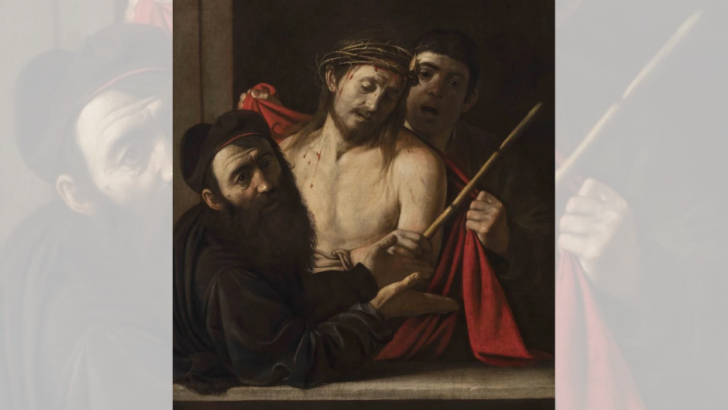The circumstances of the recovery in Dublin of a lost painting by Michelangelo Caravaggio on the walls of the dining room of the Jesuit residence in Leeson Street, a picture which is now hung with pride in the National Gallery on Merrion Square for all to see, has given the painter a special appeal to Irish devotees of art.
Therefore, the recent report that another ‘lost Caravaggio’ has been found in Spain is of special interest to us here. But as is so often the case these days, the initial reports, while gaining headlines, do not reveal the whole story.
Ecce Homo
Now in the Prado for the time being, the picture is entitled “Ecce Homo” (after the passage at John 19: 5) from the words used by Pontius Pilate to the crowd when he brings out the tortured Jesus, crowned with thorns and partly covered by a regal purple cloak, to appeal to their sympathy some think, to deride him as others think, in either case hoping to have them call for his release.
The low estimate of €1500 at the auction has now blossomed into € 35 million. The painting is set for a golden future, it might seem”
Though when the offer was made to the crowd, for the authors of the text, it was symbolic of all humanity rather than merely the Jews of Jerusalem, preferred Barabbas the thief.
The picture at the centre of the present news was prevented from being auctioned by the Spanish authorities back in 2021. Then it was attributed to a minor Spanish painter. This arrest has now made a difference, as the low estimate of €1500 at the auction has blossomed into €35 million. The painting is set for a golden future, it might seem.
And yet these excited news reports overlook an important element in the situation. There already is an ‘Ecce Home’ by Caravaggio, expertly dated to around 1605, hanging in an Italian gallery, the Palazzo Bianco, Genoa, on ready display.
Compositions
The compositions of the rival pictures are different, providing yet more material for debate. So which is ‘the real one’? Or rather which has primacy? That is the sort of dispute involving experts that occurs all the time in history of art matters.
I suspect that in the end, whenever that is, despite the publicity, the Italian picture will come to be considered the ‘genuine’ one, and the Spanish piece is a copy by a friend or a follower of Caravaggio, who had no studio or regular assistants. The ‘Ecce Homo’ was one of three commissioned from different painters by an influential Italian Monsignor. He turned down the Caravaggio.
‘Ecce Home” shows the pale frail body of the tortured Jesus in contrast to the violent dismissiveness of the custodian and Pontius Pilate himself”
In any case these academic squabbles should not distract from the far more essential matter of the image itself. It is undoubtedly a weaker image than ‘The Taking of Christ’ hanging in Dublin, which is a powerful picture filled with the passions of treachery and power.
‘Ecce Homo’ shows the pale frail body of the tortured Jesus in contrast to the violent dismissiveness of the custodian and Pontius Pilate himself. The seemingly powerless man has for many Christian’s an intended sharp contrast with the all-powerful Christ: as Jesus said to Pilate “You have no power over me.” (John 19:11).
Illusion
All too often the appearance of power is merely an illusion. Pilate looks powerful, but in the mind of the authors of the text which the painter tries to reflect, it simply does not hold the kind of real power that the tormented Jesus really does. These pictures provide food for thought, an education for the emotions.
But in effect, these two images are not ‘holy pictures.’ Caravaggio was a genius, but he was also a man accustomed to violence. His last years were spent in flight after killing a man in a stupid row.
They are deeply human pictures, which express deeply held passions, fears and outcomes”
Art is not made just to admire. It is made to change how we see the world, to give the viewer a new pair of eyes. They are images of treachery and torture akin to what is reported in our daily news. They are deeply human pictures, which express profoundly held passions, fears and outcomes.
Never mind the supposed price tag now set on the ‘new Caravaggio’. We need to think of the reality behind them, and to see Jesus as an exemplar of all the wretched of earth who are at the mercy of powerful figures and agencies which they cannot affect but which can destroy them. It is Mexico, Burma, Sinkiang and Ukraine. Above all, at the current moment it is Gaza.


 Peter Costello
Peter Costello The “new Caravaggio” now on display in the Prado, Madri
The “new Caravaggio” now on display in the Prado, Madri